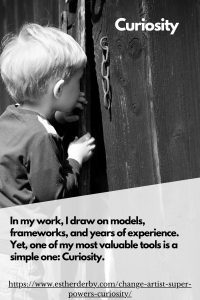
In my work, I draw on models, frameworks, and years of experience. Yet, one of my most valuable tools is a simple one: Curiosity.
In an early meeting with a client, a senior manager expressed his frustration that development teams weren’t meeting his schedule. “Those teams made a commitment, but didn’t deliver! Why aren’t those people accountable?” he asked, with more than a hint of blame in his voice. As I spent more time in the organization, I heard other managers express similar wonderment (and blame).
I also noticed that whenever someone asked, “Why aren’t those people accountable?”—or some other blaming question–problem-solving ceased.
I know these managers wanted to deliver software to their customers as promised. However, their blaming questions prevented them from making headway in figuring out why they were unable to do so.
Curious Questions
I started asking different questions–curious questions.
- Who makes commitments to the customers, and on what basis? How do customer commitments, team commitments, and team capacity relate to each other?
- When “those teams” make commitments, Is it really the people who will do the work committing, or someone else?
- What does “commitment” really mean here? Do all parties understand and use the term the same way?
- What hinders people from achieving what the managers desire? Do teams have the means to do their work?
- What‘s at stake, for which groups of people, regarding delivery of this product?
- How do developers feel about working in this organization?
- What is it like to be a manager in this organization?
- How do customers experience this organization?
Over time, I worked with others in the client organization to learn about these (and other) factors. We developed and tested hypotheses, engaged in conversations, made experiments, and shifted the pattern of results.
When Blame Receded, Curiosity and Problem-Solving Started
For the most part, managers no longer ask blaming questions. They ask whether teams have the data to make decisions about how much work to pull into a sprint. Further, the managers examine what they themselves say and do to reduce confusing and mixed messages. They review data, and adjust their plans.
Curiosity uncovered contradictions, hurdles, confusion, and misunderstandings. All of which we could work on to improve the situation.
So, there you have it. Curiosity is my number one Change Artist Super Power, and it can be yours, too.







0 Comments